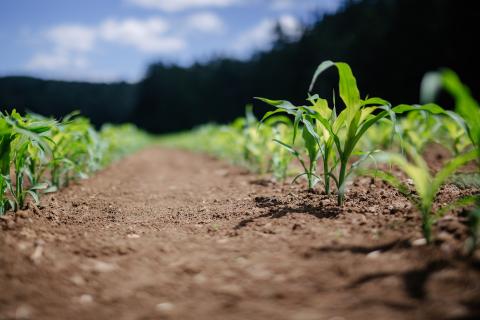Aside from the impact upon soil, ‘risky crops’ are often those which have a potentially higher financial burden through the obstacles of production. Rising input costs, labour shortages and ever increasing inflation presents additional challenges to high-risk, high-reward crops. These two elements (soil management and economics) are additionally impacted through the changing climate with record temperatures and rainfall events.
Root crops, maize and field vegetables are often at high risk for soil degradation. The likely drastic requirements for cultivation during seedbed preparation is a vast source of emissions through direct carbon losses from soil alongside the burning of fossil fuels from machinery. Cultivating soils and the subsequent disturbance allows for greater oxidation of the soil profile, therefore promoting the fast metabolism of aerobic species of microorganisms which utilise the ‘active’ pool of soil organic matter for respiration, consequently releasing CO2 as a by-product. Furthermore, cultivation of soil which reduces the stability of the soil structure can also be at risk of direct losses of carbon bound to soil aggregates through processes such as erosion either through wind-blow, run-off or direct soil loss. Therefore, depending upon a number of factors such as previous cropping, soil type, intensity of cultivation and moisture content, cultivated soil will lose soil organic matter at differing rates. Where land is under continual cultivation, as is much of UK arable land, reducing the frequency, depth and intensity of cultivations will reduce this soil carbon loss alongside providing alternative carbon sources as feedstock for microorganisms when cultivation is required.
Changing the crop establishment system to reduce the frequency and intensity of cultivations will provide an immediate reduction in farm greenhouse gas emissions. Increasing organic carbon within the soil requires the building of soil organic matter through methods such as diversifying crop rotation, reducing tillage (frequency and depth) and utilising cover cropping to maintain a living root.
Long-term rotational planning can increase the resilience of soil, using previous and subsequent cropping and management choices to minimise the impact of risky crops. To reduce the ‘risk’ of risky crops soil protection is central. Ensuring that soils are covered throughout the rotation and contain a living root for as high proportion as possible helps guard the soil from physical degradation from climatic events. Therefore, consider growing a cover crop before spring planting to scavenge nutrients over the winter period and condition soils, alongside aiming to re-plant a cover as soon as the risky crop is harvested to avoid long over-winter periods of soil erosion. Maximising the inherent soil structure and functionality throughout the rotation creates a more resilient baseline where the stresses of high cultivation, inputs and exposure to the elements occurs in high risk crops.
In grassland systems herbal leys, diverse swards and a rotational or mob grazing platform provides an excellent starting point for soils before a high-risk crop or to repair potential damage. Likewise a diverse arable rotation which incorporates cover, inter, companion or catch-cropping to protect the soil surface and provide additional rooting architecture will be a huge benefit; tired land, used to high input use, heavy cultivation and monoculture systems will be less resilient to stress (environmental, mechanical etc) than a healthy vibrant soil.
A healthy soil is likely to provide better economic returns – with processes such as fertility, water infiltration, gas exchange, rooting capacity and nutrient availability all benefited by a well structured, high quality soil. Soil organic matter can often indicate the health of a functional mineral soil, with the higher the percentage content normally suggesting the best quality. Understanding how soil organic matter can be lost during high risk cropping processes (discussed earlier) can help to mitigate and safeguard it within the rotation. Losing soil organic matter continuously depletes the soil fertility and consequently the likely economic potential of that land.
This blog was written by Emma Adams, one of our Farm Carbon and Soils Advisors, to read about our team head here.
More information:
For further information on species selection of cover crops and the results of the Farm Net Zero trails please see the resources below:
- Farm Net Zero Fact Sheet, Risky Crops: Field Vegetables in Rotation – Best Practices for Soil Health Risky Crops – Field Vegetables in Rotation – Best Practices for Soil Health – Farm Carbon Toolkit
- Farm Net Zero Fact Sheet, Cover Crops FNZ FactSheet – cover crops.pdf (farmcarbontoolkit.org.uk)



